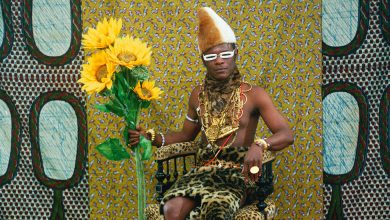Julie Saul, Effervescent Manhattan Gallerist, Is Dead at 67

Julie Saul, an energetic and outspoken longtime Manhattan gallerist who championed, often fiercely, photographers like Sally Gall, Andrew Bush and Arne Svenson, as well as multimedia artists like Sarah Anne Johnson, Maira Kalman and Roz Chast, died on Feb. 4 at her family’s home in Tampa, Fla. She was 67.
The cause was acute myeloid leukemia, said her sister, and only immediate survivor, Linda Saul-Sena.
Ms. Saul, who was educated as an art historian, had been working at the Metropolitan Museum of Art in the early 1980s when she teamed with Nancy Lieberman, an art director working in advertising, to sell photography out of Ms. Lieberman’s Upper West Side apartment. They were young and entrepreneurial, and, as Ms. Lieberman pointed out in an interview, in those days you could start a gallery on a shoestring.
Their first artists were Ms. Gall, who makes sensuous investigations of the natural world, from clouds to caves to bugs; Zeke Berman, whose surrealist tableaus tread a line between sculpture and photography; and Mr. Bush, who would become known for a wide-ranging body of work.
A windfall from an estate gave the pair the seed money to open a gallery in SoHo. Five extraordinary prints they found in an attic — by the early-20th-century greats Paul Outerbridge, Tina Modotti and Edward Weston — sold quickly.
Their first show, in May 1986, was of Mr. Bush’s work, lush and evocative domestic interiors from a crumbling Irish country house.
In 2013, a show by Mr. Svenson drew a storm of controversy. (By then Ms. Saul was on her own as a gallerist, having shifted, along with the rest of the art world in the 1990s, from SoHo to Chelsea.) Inspired by the Hitchcock movie “Rear Window,” Mr. Svenson had taken a series of photographs from his apartment of the inhabitants of the new glass-walled building that had gone up across the street from him in TriBeCa. Called “The Neighbors,” the portraits were intimate and tender — the curve of a man’s back, a child’s hand, a small dog gazing up at his owner — but there were no faces or identifying details.
Just before the show opened, the family of one of the subjects, alerted by an article in a small downtown newspaper that identified their building, filed a cease-and-desist order against the show and a lawsuit against Mr. Svenson claiming invasion of privacy.
What followed, as Mr. Svenson put it, was tabloid bedlam. Television crews parked outside the gallery and his apartment, and he was pilloried as a villain and a creep (he was also held up as a hero of First Amendment rights).
Ms. Saul became his vociferous defender.
“Let’s charge forward,” he recalled her telling him. She appeared on morning television shows on his behalf, inviting audiences to come see, as he remembered in an interview, “these beautiful photographs” and providing her gallery’s hours.
“She had been so strident in defending my rights to take these photos and her right to show them,” Mr. Svenson said. “And then to appear on television and invite everyone to Chelsea just normalized it all.”
The case was resolved in Mr. Svenson’s favor in 2015.
Ms. Saul was also a vocal critic and could be jaw-droppingly frank, as Ms. Gall — who exhibited with Ms. Saul for 33 years, longer than any other artist — recalled by phone: “I had been photographing water and waves for years, and Julie at one point said, ‘You got to quit; you’ve seen one wave, you’ve seen them all.’ Sometimes I’d say to her, ‘I can’t believe you just said that out loud!’”
By the early 2000s, Ms. Saul had broadened her gallery’s scope from photography. She scooped up Ms. Kalman, the mischievous artist, illustrator and author, in late 2001 after Ms. Kalman and Rick Meyerowitz’s “Newyorkistan” map — a delirious sendup of the city’s tribalism — appeared on the cover of The New Yorker. Ms. Kalman had never shown in a gallery before.
“I had never wanted to be in the art world,” she said. “I thought it was a daunting place. But Julie took me in and protected me like a hen with her chick.”
The work Ms. Kalman exhibited with Ms. Saul was mostly her paintings. However, they often strayed from traditional gallery practices. In 2005, Ms. Kalman, Ms. Saul and Isaac Mizrahi, the fashion designer and cabaret singer, performed together at the New York Public Library in a song cycle written by the composer Nico Muhly and based on Strunk & White’s “The Elements of Style,” the beloved grammar primer, which Ms. Kalman illustrated that same year.
“For all the years I was doing fashion shows,” Mr. Mizrahi said, “I was trying to tell a story about a self-made woman, who was wily and smart and wickedly funny, and in the end what I realized is that it was Julie.”
Julie Meredith Saul was born on Dec. 31, 1954, in Tampa, Fla. Her mother, Joan (Perlman) Saul, was a homemaker, and her father, Marvin William Saul, was a garment manufacturer.
She earned a bachelor’s degree in art history from Newcomb College, the coordinate women’s college of Tulane University in New Orleans, in 1976, and a master’s in art history and archaeology from New York University’s Institute of Fine Arts in 1982. In between degrees, she was assistant director and then director of the Tampa Bay Art Center.
Ms. Saul closed her Chelsea gallery in 2019 when she lost her lease.
At her death, she was working on a project she had begun 20 years earlier to promote the life and legacy of Berthe Weill, an early-20th-century Parisian art dealer. Ms. Weill called her gallery a “place aux jeunes” for the young artists she showed — among them Henri Matisse, Raoul Dufy, Amedeo Modigliani,Diego Rivera and, notably, Picasso. But by the end of the century Ms. Weill seemed to have been written out of art history, save for a mention here and there.
Ms. Saul had been on Ms. Weill’s trail since she came upon a reference to her in Michael C. FitzGerald’s 1994 book, “Making Modernism: Picasso and the Creation of the Market for Twentieth-Century Art.”
Ms. Weill was the child of a seamstress and a rag picker, Ms. Saul learned; she had an unerring eye for good work, and a sharp tongue to match her sharp eye. In 1933 she had self-published a dishy and eccentric memoir, “Pan! Dans l’Oeil!” or “Pow! Right in the Eye!” And in 2001, Ms. Saul was delighted to discover, a French art historian named Marianne Le Morvan had published a scholarly biography.
Ms. Saul was determined to get Ms. Weill’s memoir in print.
The forthcoming book “Pow! Right in the Eye! Thirty Years Behind the Scenes of Modern French Painting,” was done in collaboration with three people: Lynn Gumpert, director of the Grey Art Gallery at New York University; Ms. Le Morvan; and William Rodarmor, a translator. It will be followed by an exhibition at the Montreal Museum of Fine Arts in the summer of 2024, and at the Grey gallery the next year.
Ms. Saul identified with Ms. Weill’s grit and her streak of independence, as she said in a talk she delivered by Zoom for a conference at the Victoria & Albert Museum in London in December. Wrapping up her speech, Ms. Saul quoted from Ms. Weill’s memoir:
“I’ve had disappointments, but also many joys, and despite the obstacles, have created an occupation for myself that I thoroughly enjoy. On balance, I should consider myself lucky … and I do.”





